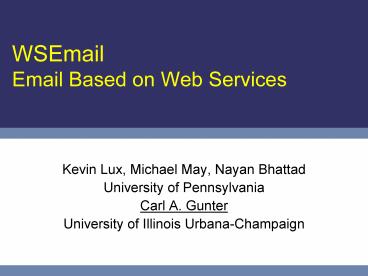WSEmail Email Based on Web Services - PowerPoint PPT Presentation
Title:
WSEmail Email Based on Web Services
Description:
Aim: use web services as a new foundation for email as a way to improve security, ... process of translating down since TulaFale cannot express timed nonces easily ... – PowerPoint PPT presentation
Number of Views:101
Avg rating:3.0/5.0
Title: WSEmail Email Based on Web Services
1
WSEmailEmail Based on Web Services
- Kevin Lux, Michael May, Nayan Bhattad
- University of Pennsylvania
- Carl A. Gunter
- University of Illinois Urbana-Champaign
2
Internet Email
- Based on a collection of protocols
- SMTP, POP, IMAP, S/MIME
- Evolved over a vast installed base
- Shortcomings
- Flexibility
- Security
- Integration
3
Approaches to Improvement
- Make incremental changes and overlays for the
existing protocols - Redesign the system from a low level
- Example instant messaging
- Create a design from another high-level
foundation - Example use HTTP and SSL
4
WSEmail Project
- Began at Penn with support from Microsoft
- Aim use web services as a new foundation for
email as a way to improve security, flexibility,
and integration - Ongoing project at both UIUC and Penn see
http//wsemail.ws - Expanding to the AMPol Project
5
Basic Operation
Distributed Components and Messages
- SD Sender Domain
- SC Sender Client
- SS Sender Server
- RD Receiver Domain
- RS Receiver Server
- RC Receiver Client
Sample Messages
6
Applications
- Integrated instant messaging
- Workflow based on routed forms
- On-demand attachments
7
Instant Messaging
8
Workflow Systems
9
On-Demand Attachments
10
Architecture
- Server Mail Transfer Agent (MTA)
- Core
- Plugin
- Client Mail User Agent (MUA)
- Overall aim support for secure dynamic
extensions - Compare active networks concept
11
MTA Core
12
MTA Plugins
Server UML Server Plugins UML
13
Client MUA
14
Implementation
- WSEmail implemented over .NET framework with Web
Services Enhancement (WSE) - Messages stored on SQL Server 2000
- Version 1.0 is C .NET-managed code created with
MS Visual Studio - 68 interfaces
- 343 classes
- 30 projects
- DNS SRV records used for routing.
15
WSEmail Test-bed
Machines Pentium4 Network 100Mb switched
Ethernet Client Machines 2.8GHz, 512MB
RAM Server (Si) 2.8GHz, 1GB RAM Database (Sdb)
2.4GHz, 1GB RAM Internet Emulator (Se) 2.8GHz,
512MB RAM
16
Parameters
- Each client will send 2000 requests to Si
- Operations send message, list headers, retrieve
message, delete message (each with equal chance) - Sent messages include local recipient (a user on
Si) and an external recipient (a user on Se).
- Test coordinator holds test parameters that
clients receive and parse - Message database is pre-populated with a few
entries - Test coordinator signals test start
- Clients non-deterministically pick an action to
perform, based on upon test parameters
17
Results
- Average latency for client .274 sec / msg
- Rate of 1786 msg / min at server
- Client machines sent 36.4MB and received 369.4MB
- Test took 1824 sec to execute
- Benchmark comparison to SMTP on our machines
showed .170 sec / msg for clients with messages
of similar size - Benchmark UW Parkside peak server usage figures
were 1716 msg / min
18
Theory
- On Demand Attachments Protocol
- Nine messages, four parties
- Complex messages
- Want to prove that receiving an attachment means
it was sent by the sender in the from field
19
Proof Technique
- Reduce the complex and redundant messages
- Eliminated headers, irrelevant to/from fields
- Choose a verifier that can evaluate protocol
security - Used ProVerif by Bruno Blanchet
- Formalize the messages and parties for the
verifier - Used TulaFale by MS Research
- Compiled TulaFale scripts into ProVerif syntax
- Result was a smaller formal version in a machine
checkable format - Lost injectiveness in the process of translating
down since TulaFale cannot express timed nonces
easily
20
Message Example
- First message is from the Sending Client to the
Sending Server - Email text, attachment, destination address, user
name - Everything is signed user name token method
- Abstractly
- SC ?SS SS (RC RS) Msg Attachment
- Production and Destruction Rules in TulaFale
- predicate mkMsg1(SCitem, noncebytes,
creationstring, attachmentstring, emailstring,
TOuserstring, TOdomstring, Msg1item,
Msg1Signeditem) - - destUserAtDomain UName(TOuser, TOdom),
- isUserTokenKey(TokSC, SC, nonce, creation,
KeySC), - Msg1 Message1(TokSC, attachment, email,
destUserAtDomain), - mkSignature(Sig, "hmacsha1", KeySC,
Msg1), - Msg1Signed Sig Msg1.
- predicate isMsg1(Msg1Signeditem, SCitem,
TOdomstring, TOuserstring, attachmentstring,
emailstring, destUserAtDomainitem, Msg1item)
- - Msg1Signed Sig Msg1,
- Msg1 Message1(TokSC, attachment, email,
destUserAtDomain), - isUserTokenKey(TokSC, SC, nonce, creation,
KeySC), - isSignature(Sig, "hmacsha1", KeySC,
Msg1), - destUserAtDomain UName(TOuser, TOdom).
21
Result
- First pass at the formalization had errors
- We ended up with a trivially true theorem
- Second pass was more careful
- Each messages was checked for correctness and
reachability - Performance problems
- ProVerif couldnt handle such a large protocol
- Blanchet created a version of ProVerif that
skipped some extra parsing steps that were
performed after the theorem was proved - We finished with a theorem shown to be true, but
without a derivation tree justifying the theorem - Would have made debugging hard
- Future efforts will be made at making the prover
more efficient
22
Summary
- Web service foundation for messaging (WSEmail)
may address issues with flexibility, integration,
and security. - Designed architecture and built WSEmail system on
.NET. - Studies show
- Interesting applications
- Useful theory
- Satisfactory performance
23
Future Work
- AMPol Adaptive Messaging Policy
- Effort to create messaging system where elements
can adapt to policies with grace and security. - Key architectural elements
- Policy model
- Policy discovery
- System extension and policy merging































